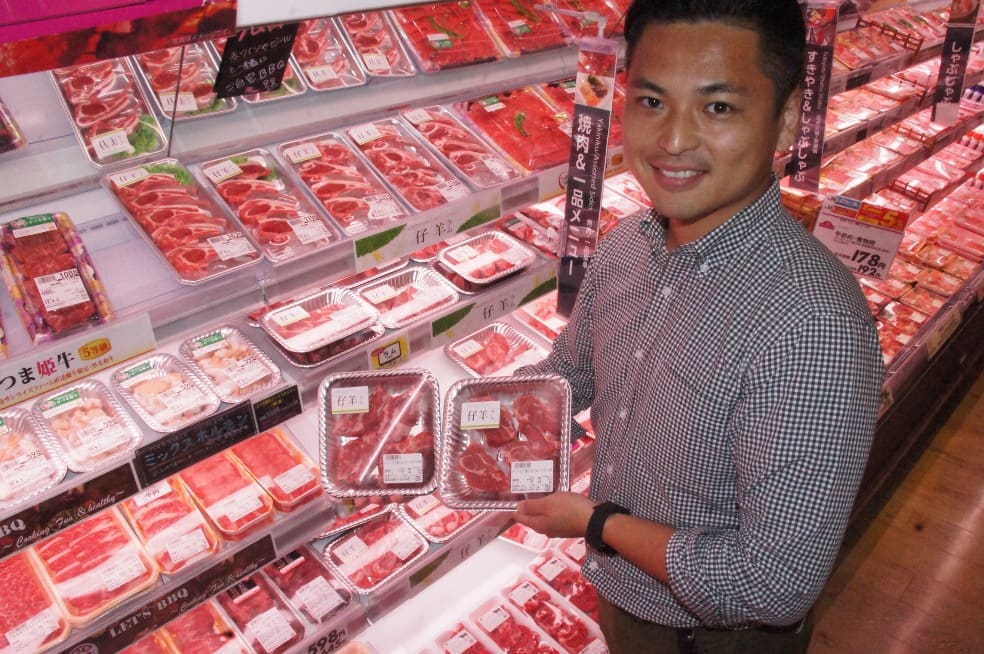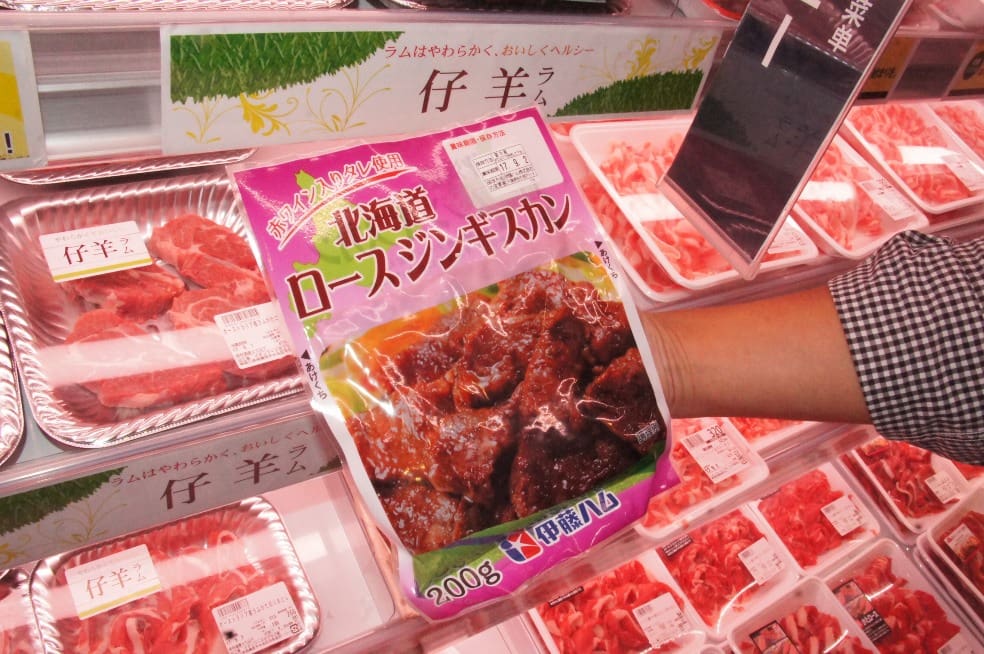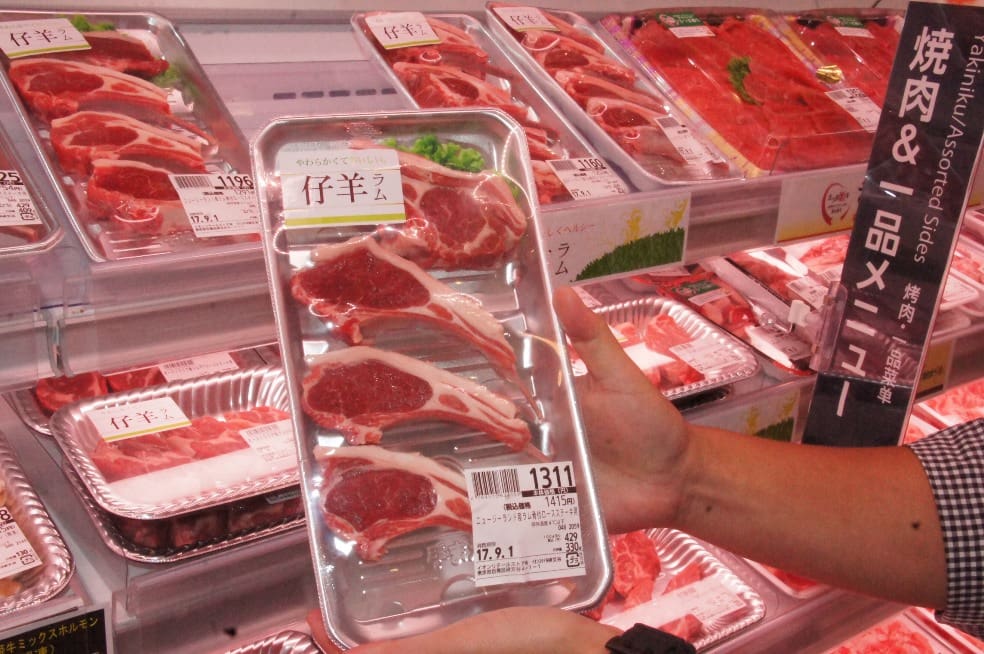
MLA Japan business development manager Kazu Mitsuhashi with samples of Australian lamb chuck roll in an up-market Aeon supermarket in Tokyo
WHILE lamb consumption in Japan remains heavily skewed towards the northern island of Hokkaido, consumers in less-traditional areas like Tokyo and Osaka are increasingly showing interest in lamb bought at retail, for home consumption.
Historically, Australian lamb has mostly been found in the food service sector on Japanese hotel and restaurant menus, but increasingly more adventurous consumers are showing interest in lamb for home preparation.
A recent visit to the large Aeon supermarket chain’s upmarket Himonya outlet in central Tokyo found a good selection of Australian and New Zealand lamb on display.
The Aeon store visited was a brand new ‘concept’ market being trialled by the Aeon retail group, featuring high-end fixtures and fittings, ‘open plan’ layout and large showcase areas. Premium packaging (reference the eye-catching metallic trays in these photos) was evident, as was a heavy emphasis on value-added items.
Aeon operates a range of supermarket chains in Japan including the Jusco outlets, one of the larger supermarket retailers in the country.

Value-added items like this marinated Genghis Khan barbecue thinly-sliced lamb shoulder meat were popular in the Aeon store
Most of the lamb on display at Aeon’s Himonya store in Tokyo was either thinly-sliced shoulder meat like chuck roll, racks, chops or cutlets. Value-added, marinated, thinly-sliced lamb was also on display.
“Thinly sliced Australian lamb shoulder has become a popular cultural culinary dish promoted through the Genghis Khan barbecue style,” Meat and Livestock Australia Tokyo business development manager Kazu Mitsuhashi, told a party of visiting Australian livestock producers.
“Consumers on the island of Hokkaido love their lamb, and they consume close to 70 per cent of Japan’s total imports, but we are also seeing more presence of lamb in retail settings in Tokyo,” he said.
Currently Australia has about 70pc market share for lamb imports to Japan, with the balance held by New Zealand. Total Australian chilled and frozen lamb exports to Japan for the 2017 year to November have totalled close to 8000 tonnes, about 70pc of which was chilled.
Carcase and cut size consideration
For retail applications like Himonya, Mr Mitsuhashi said lamb carcase size and cut-size was a consideration in presentation, especially for items like cutlets and chops.
“Some Japanese supermarket wholesale meat buyers like smaller-sized chops and cutlets, because they can put more on a tray,” he said.

Cut size on items like lamb cutlets is important at retail in Japan where customers tend to buy to a price per portion.
“They say some Australian cutlets can get to large – meaning only two or three to a retail tray – while smaller New Zealand carcases may yield four cutlets or more on the same tray, for the same price,” he said.
“Some retail buyers, say they find the cuts from smaller carcases easier to sell, because the Japanese consumer looks at the price-point, per piece – not the overall weight.”
The issue only applies to certain cuts, and is much less important for popular shoulder items like chuck roll, Mr Mitsuhashi said.
MLA consumer surveys show the three main reasons offered by Japanese consumers for not buying lamb are ‘not being familiar with the product’ (47pc), ‘don’t know how to cook it’ (35pc), and ‘it’s not available’ (31pc). While there is rising lamb awareness among businesses and consumers, overall awareness remains low compared to other markets.
In-store promotions offering consumers samples of lamb was still an important marketing strategy being used by MLA in selected key stores in the Japanese retail market. In-store demonstration kitchens also helped introduce more consumers to lamb, using one of MLA’s Japanese ‘Lambassadors’ – local chefs with a passion for cooking with lamb.
Sheepmeat remains a minor protein in Japan, with national consumption only 200 grams per capita compared to fish, which totals 60kg/year. Despite that, Japan remains Australia’s largest lamb export market in Asia. Chilled lamb makes up 40pc of Australia’s sheepmeat exports, followed by frozen lamb 26pc, and frozen mutton 34pc. Shoulder meat made up 57pc of sales in 2016, primarily used in Genghis Khan barbecue, followed by manufacturing meat 22pc, racks 8pc and legs 7pc.
In the food service sector, while Genghis Khan sheepmeat barbecue restaurants are the major outlet for Australian sheepmeat overall, there is a trend emerging in modern foodservice to incorporate Australian lamb on menus as a point of difference. In order to demonstrate their point of difference, innovative chefs in Japan are experimenting with Australian lamb in diverse cuisine styles including Italian, middle-eastern, Chinese and Japanese.

HAVE YOUR SAY